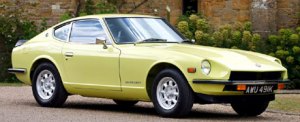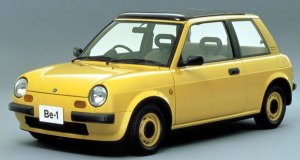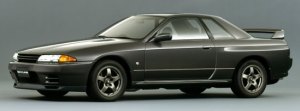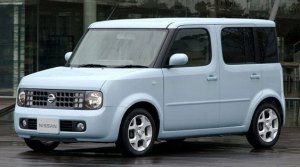
| - Mitsubishi - 24% |
 Headquarters
: Yokohama
Headquarters
: YokohamaTechnical Center : Kanagawa
Proving ground : Hokkaido
Plants in Japan: Oppama, Tochigi, Kyushu, Yokohama, Iwaki.
Overseas facilities:
Technical Center: Farmington Hills (Michigan, USA), Cranfield (UK)
Proving ground: Arizona (USA)
Design studio: San Diego (USA), London (UK)
Main overseas plants:
- Smyrma (Tennesse, USA): Altima, Maxima, Frontier, Xterra, Pathfinder
- Canton (USA): Altima, Quest, Titan, QX56
- Sunderland (UK): Qashqai, Juke, Note
- Barcelona (Spain): NV200, Pathfinder
- St. Petersburg (Russia): X-TRAIL, Murano, Teana
- Guangzhou (China, JV with Dengfeng): March, Tiida, Sunny, Slyphy, Qashqai, X-Trail, Teana, Murano
- Wuhan (China, JV with Dengfeng): trucks and vans
- Kancheepuram (India): Micra, Sunny
- Bangsaothong (Thailand): March, Tiida, Teana, Frontier
FY2017/18: 5,770,000 units
FY2016/17: 5,626,000 units
FY2015/16: 5,423,000 units
FY2014/15: 5,318,000 units
FY2013/14: 5,188,000 units
FY2012/13: 4,914,000 units
FY2011/12: 4,845,000 units
FY2010/11: 4,185,000 units
FY2009/10: 3,515,000 units
FY2008/09: 3,411,000 units
FY2007/08: 3,769,886 units
FY2006/07: 3,483,000 units
FY2005/06: 3,569,295 units
FY2004/05: 3,389,000 units
FY2003/04: 3,057,000 units
FY2002/03: 2,711,000 units
FY2001/02: 2,597,000 units
Infiniti sales:
2018: 233,445 units
2017: 246,492 units
2016: 230,000 units
2015: 215,250 units
2014: 186,200 units
2013: 164,000 units
2012: 173,000 units
2011: 146,000 units
2007: 151,683 units
Reference:
http://www.nissan-global.com/EN/IR/LIBRARY/AR
 Fairlday 240Z (1969)
Fairlday 240Z (1969)Jitsuyo Jidosha Co., Ltd., another predecessor of Nissan, was established in Osaka in 1919 to manufacture three-wheeler designed by American engineer. The company imported machine tools, components and materials from the U.S., and thus was said to be one of the most modern automobile factories. Kwaishinsha Co. and Jitsuyo Jidohsa Co. merged in 1926 to form Dat Jidosha Seizo Co., which, in 1931, became affiliated with Tobata Casting.
Jidosha-Seizo Kabushiki-Kaisha ("Automobile Manufacturing Co., Ltd." in English) was established on 1933, taking over all the operations for manufacturing Datsuns from the automobile division of Tobata Casting, and its company name was changed to Nissan Motor Co., Ltd. on 1934. The company had grand plans to mass-produce 10,000-15,000 units per year. The first small-size Datsun passenger car rolled off the assembly line at Yokohama plant in 1935.
 Fairlady 300ZX (1983)
Fairlady 300ZX (1983)During the war, Nissan manufactured military trucks and military engines for planes and boats. Although the Yokohama plant escaped damage during the air raids, over half of the plant was requisitioned by the Occupation Forces for approximately ten years after the war. Nissan was also handicapped in the early postwar period by the fact that many leading auto dealerships, previously affiliated with the old Nissan network, switched to the rising Toyota. In a move to recover from the technological vacuum of the wartime years, Nissan concluded a technical tie-up with British car maker Austin in 1952, and produced Austin cars under license.
 Be-1 (1987)
Be-1 (1987)Meanwhile, it rebuilt its R&D and production. The Bluebird and Cedric were launched in ’59 and ’60 respectively. The merge with Prince Motor in 1966 added Skyline and Gloria name to its collection. That year also saw the launch of its best selling small car, Sunny. Taking advantage of the strong economic growth and export, Nissan, like other Japanese car manufacturers, increased production rapidly from 1960s to 1980s.
Export to United States was especially crucial to its growth during that period. Nissan was first known to American thanks to the 240Z coupe of 1969. This car combined a handsome look, good performance and affordable price, no wonder it was a hit in the USA and eventually killed the once world-dominating British sports car industry. The energy crisis in 1973 further helped Nissan (as well as Honda and Toyota) to eat into the market share of Detroit's Big 3. When protectionism arose, Nissan had already established factories in the United States and UK, localizing its production.
 Skyline GT-R (1989)
Skyline GT-R (1989)Its fortune rose to a peak in the late 1980s, when it offered the widest range of cars in the world, including Infiniti luxury cars and many niche models, such as the classical series Be-1, Pao, Figaro and S-Cargo, and some exciting coupes like Fairlady 300ZX, Silvia 200/240ZX and Skyline GT-R. However, many of those cars were not profitable. When Japan went into recession in 1990s, Nissan became a victim of its complication. Loss piled up to the extent that it came close to bankruptcy. In 1999, it had to sell its controlling stake to Renault, ending its independence.
Under the leadership of Renault man Carlos Ghosn, Nissan started a reform that cut excessive production capacity and unprofitable models, combined platforms and increased the percentage of common parts. Ghosn also broke Japan's lifetime employment tradition, dismissing underperforming staffs. Within 3 years, "Le Cost Killer" successfully turned the company back to black and settled all debts in the next 2 years. Ghosn and Nissan became a famous example of reforming Japan's problematic giant enterprizes.
 Cube Mk2 (2002)
Cube Mk2 (2002)In the 2000s, Nissan and Renault began integrating their platforms and powertrains to save costs. To some extent, the rationalization cost Nissan some of its unique character. Fortunately, Ghosn greenlighted the development of FM (front-midship engine) platform that resulted in some exciting Infiniti models, 350Z and new GT-R. This helped rebuilding its brand image.
In 2016, Nissan acquired the controlling stake of Mitsubishi amid the fuel economy scandal of the latter.